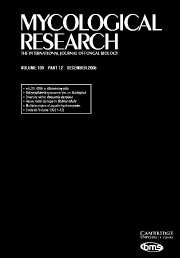No CrossRef data available.
Abstract
Mycological Research News features: Numbers of insect and plant species.
Eleven papers are included in this issue. Ectomycorrhizal forests have been discovered in Guyana, and DNA profilesfrom forest soils demonstrate that ectomycorrhizal fungi are adversely affected by burning. Molecular andmorphological studies have led to a reappraisal of the relationships and generic concepts of smuts on certaindicotyledons, and also of ‘subcentric’ Achlya species and allied fungi, leading to the recognition of a new genus.
Five papers concern the molecular characterization and variability of plant pathogens: Alternaria species-groupsassociated with core rot of apples; the identification of Verticullium longisporum on oilseed rape; Colletotrichumgloeosporioides on Stylosanthes species ; the transposa and vacuma groups of Botrytis cinerea; and Pyrenophora teres. Inaddition, phytotoxic metabolites have been identified in Sarocladium oryzae.
A revision of Dioicomyces (Laboulbeniales) is also presented and the following new scientific names are introduced:Newbya gen.nov.; Achyla truncatiformis, Dioicomyces denticulatus, D. ladoi, and D. leptalei spp. nov.; Colletotrichumgloeosporioides f. stylosanthis f. nov.; C. gloeosporioides f. sp. stylosanthis f. sp. nov.; N. apiculata (syn. Achylaapiculata), N. braziliensis (syn. A. braziliensis), N. curvicollis (syn. A. curvicollis), N. megasperma (syn. A. megasperma),N. oblongata (syn. A. oblongata), N. oblongata var. gigantea (syn. A. oblongata var. gigantean), N. oligocantha (syn. A.oligocantha), N. pascuicola (syn. Aplanopsis pasuicola), N. polyandra (syn. Achlya polyandra), N. recurva (syn. A.recurva), and N. stellata (syn. A. stellata) combs nov.
Information
- Type
- Mycological Research News
- Information
- Copyright
- © The British Mycological Society 2002

